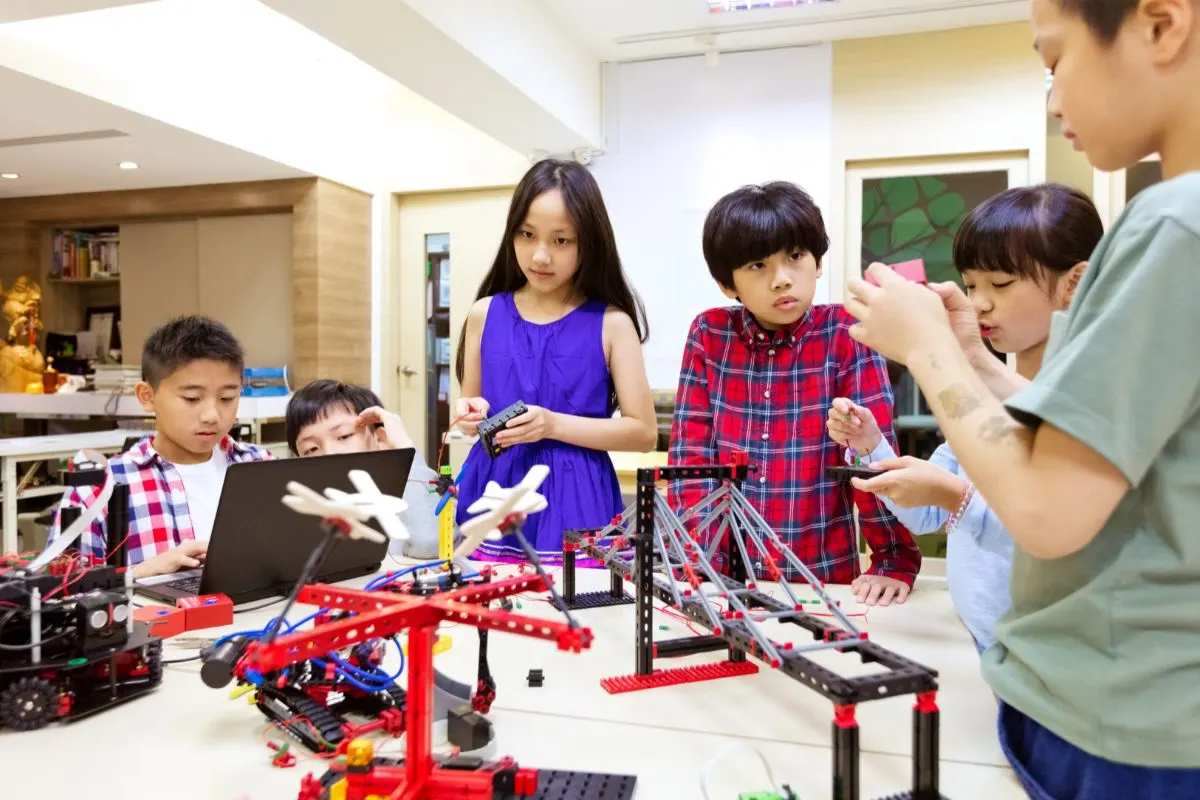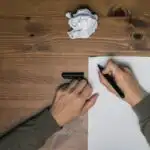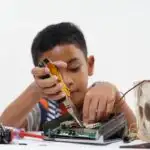Science is so fascinating, but it can sometimes be difficult to convince 11-year-olds that this is the case.
In order to capture their attention, you need to come up with something that will not only educate them, but also entertain them.

Below, we have listed 55 super fun science fair projects that 6th graders will love to try.
1. Carbon Sugar Snake
To start off this list, here’s an experiment that focuses on three heat-dependent chemical reactions.
By lighting up some baking soda and sugar with a match, you can create a ‘snake’ made from carbon and sugar that continues to grow for up to 20 minutes!
2. Turn Milk into Plastic
With this experiment, you can teach your kids how to make plastic from lots of different materials, even including milk.
Once you’ve created the milky plastic, you can even melt and mold the organic casein polymer to make a new product.
3. Which Wheel Works Best?
This is a great way to teach kids about acceleration and velocity, and how the material of a wheel can affect the speed and resistance of a skateboard.
We don’t recommend trying this experiment if you’re not a very good skateboarder, however, as this could potentially result in injury.
4. Baking Soda-Powered Boat
By assembling a plastic bottle with some vinegar, baking soda, and a straw, you can create your very own mini speedboat.
The idea behind this experiment is very similar to making a baking soda volcano, as the chemical reaction creates pressure and movement.
5. Two-Stage Balloon Rocket
This is another experiment that kids can have lots of fun with, as well as learning all about how it works.
By attaching a balloon to the back of a straw, you can pump it up and release it across the room, allowing it to soar like a real life rocket.
6. Tiny Dancers (A Homopolar Motor)
By attaching a couple of wires and magnets to an AA battery, you can create your very own spinning ballerina!
You can even add some colorful crêpe paper to give your tiny dancer its very own tutu. Get creative, and learn all about how your dancer is spinning.
7. Magic Spinning Pen
Magnets are some of the coolest tools ever, especially when you know how to use them to create fun tricks like these.
To create this magical spinning pen, you’ll need to use some small rods, a pen, a coin, and, of course, a couple of magnets.
8. Homemade Wigglebot
Did you know that you can make your very own robot using a plastic cup with googly eyes? This ‘robot’ can walk around all on its own!
This is another experiment that will teach your children how batteries work alongside motors.
9. Electromagnetic Train
Next up, we’ve got a science project that is so easy to set up, yet it will keep your kids entertained for hours.
An AAA battery attached to some magnets will become an electromagnetic train when placed at the entrance of a copper wire tunnel.
10. Holiday Card Circuits
Say goodbye to your run-of-the-mill handcrafted Christmas cards, and say hello to these impressive holiday card circuits.
By building a super simply circuit and taping it onto some cardboard, you can bring your festive designs to life… or, should we say, ‘to light’?
11. How to Make Fizzing Lemonade
Everybody loved carbonated drinks, but not everyone knows how they work. Where do the bubbles come from?!
Use this experiment to teach your kids (and yourself) how a chemical reaction using acid can turn your still drink into a bubbly one.
12. Solar-Powered Robot Bug
This solar-powered robot bug is also known as a ‘frightened grasshopper’. Why? Because it’s scared of the light!
Once you’ve assembled your robot bug, witness how it runs around when exposed to light, but comes to a standstill once it has been covered in shade.
13. Homemade Coffee Can Camera Obscura
Have your kids ever wondered how a camera works, or do they just accept it for what it is? If so, now is the time to teach them.
This camera is so easy to make from coffee cans and construction paper, and is so interesting and fun to use.
14. Heat Sensitive Color Changing Slime
From mood rings to heat-sensitive lip gloss, it is always impressive when an object can change color. This is all thanks to thermochromic pigment.
Add some thermochromic pigment to homemade slime made from white glue and liquid starch, and watch the magic happen.
15. DIY Crystal Landscapes
Have you ever seen anything as pretty and colorful as these vibrant crystal landscapes? You will find it surprising how easy they are to make.
You’re going to need to mix together some liquid bluing with water, salt, coloring, and ammonia to create these beautiful crystal creations.
16. Glow in the Dark Jello
Uh, hello? Glow in the dark Jello? Just when you thought that jello couldn’t get any more fun and yummy, this edible experiment pops up.
Boil some light-colored Jello with tonic water, let it cool in a mold, and then turn the lights out for the real fun to begin.
17. How Do Roots Grow When the Direction of Gravity Changes?
We all know that gravity is what keeps our feet weighed to the ground, but what about plants? Does gravity affect the way they grow?
Make your own scientific container (made from a CD case), add some seeds, and switch up the directions every so often to test out this theory.
18. Seafloor Spreading Model
If you want to create a fun lesson plan to teach your students about the lithosphere, and how earthquakes occur, this is a great project to try out.
You will need to cut up a lot of paper for this project, so you can decide whether to do this beforehand, or to allow your students to fully make the project themselves.
19. The Science Behind Tsunamis
Tsunamis are terrifying natural occurrences, regardless of whether your hometown and country is at risk of them.
Sometimes, learning about something can make it seem less scary. Teach your students about tsunamis using this experiment.
20. How Acidic Waters Make Rocks Disappear
It seems impossible to imagine that rocks can become worn down by water over time. With this project, you can work out how it happens, and why.
This is a great way to teach students about the effects of acidic water, and how stone can gradually become worn down and dissolved.
21. Ice Cube vs. Wire
How could it be possible that one thin piece of wire could cleanly slice through an ice cube while leaving the rest of it intact?
Use a piece of wire and an ice cube to test the strange physics of water. To increase the fun, ask your students to guess how long it will take for the wire to split the cube.
22. DIY Heart Pump
Our bodies are fascinating vessels, and it can be so interesting to learn exactly what is going on inside ourselves.
This DIY heart pump may be a little fiddly to piece together, but once complete, you can show your students what is really going on inside their chests.
23. Engineering a Bridge

Engineering is a super fun and handy skill to have, whether it is something you want to make a career out of, or you’re just a crafty kind of person.
Use this sheet to ask your students how many popsicle sticks they think will need to create a sturdy bridge. Then, put their ideas to the test.
24. Earthquake Science Project
As we said earlier, sometimes knowing more about something (e.g., an earthquake) can make it seem a little less scary.
This project involves creating sturdy structures, and then using books as a foundation to represent the earth’s plates. See how long your structures will stay standing, and work out how to improve them.
25. Magic Cloud in a Bottle
When we were kids, we thought clouds had the same texture as cotton candy, or the inside of a pillow. Nowadays, we know differently… but, do your students?
Teach them what a cloud really is by using rubbing alcohol and a pump to recreate what it really is, but in a smaller form.
26. Pop Rocks and Soda Science Experiment
Popping candy is so fun to eat, but do you know how it works? Why does it start popping when it goes into your mouth? (More on that later.)
For now, here is a fun variation on the ‘coke and Mentos’ experiment. Add some Pop Rocks into a bottle of soda, and see what happens…
27. Biodomes Engineering Design Project
By getting your students to design their very own biodome, they can learn more about how an ecosystem works.
You’re going to need some soil, seeds, sand, rocks, and even some creepy crawlies. Add them all into a plastic bottle, and take notes of what occurs inside.
28. Displacement and Buoyancy in Metal Boats
Archimedes’s principle, or the law of buoyancy, explains why some objects sink in water, while others don’t.
Use some foil and a bowl of water to test how well foil will float, depending on its size and shape.
29. The Science Behind Edible Glass
Have you ever eaten glass? Normally we wouldn’t recommend it, but this edible glass is super tasty, and pretty easy to make.
Like real glass is formed through melted grains of sand, this glass is made from grains of sugar. Melt it on a baking sheet, allow it to cool, and then get eating (or smashing).
30. Cleaning Coins Experiment
When you begin to think about how many people have held the coins in your purse at some point, it can make your skin crawl a little. Coins are super dirty.
Try this experiment to see what material can clean coins the best, from apple juice to catsup. You’ll be surprised at how shiny your cents will be afterward!
31. Red Cabbage pH Indicator
Most people will remember learning about pH levels in school, and how much fun it was, seeing all the colors of the rainbow.
Blend up some red cabbage with water, and mix with everyday items – such as lemon juice and soda – to test their pH levels based on which color the liquid becomes.
32. Skittles Science Fair Project
Many of you may have seen this experiment through social media, with many people testing it out with their children at home.
This colorful project involves placing Skittles on a plate, and adding a couple of drops of water. Watch and see how the colors streak across each other.
33. Tooth Decay Egg Experiment
We all know that sugar is bad for our teeth, but how can you test that notion in a class of 6th graders? Well, by using some eggs!
Place hard-boiled eggs in separate containers filled with soda, energy drinks, orange juice, and milk, and wait to see how the eggs react to each liquid.
34. Science of Candy: Lightning in Your Mouth
Did you know that LifeSaver candy can glow in the dark? Yes, really! This is a great experiment to teach kids how friction can cause electricity, even in your mouth.
Go into a dark room, and chew on some wintergreen-flavored LifeSavers with your mouth open. Everyone around you will be able to see the lightning going off around your teeth.
35. Why Does Popping Candy Pop?
As we promised, here is an experiment that will teach children why popping candy does what it does!
There are tiny pockets of gas inside popping candy, which are released when exposed to liquid. Test this out by adding the candy to different kinds of liquids, from water to oil.
36. Which Fruits Rot the Fastest?
This is a pretty gross experiment, but it is still a fascinating one that the children are going to love. For this project, you will need to work with some rotting fruit.
Place different fruits in separate bowls, and observe how they decompose over the course of 14 days. Take note of what happens as they rot.
37. What Light or Heat Conditions are Favorable to Insects?
Have you ever been on your phone in a dark room, and a moth landed on the screen? Insects seem to be attracted to light… or, are they attracted to the heat of your phone?
Use this experiment to find out what conditions attract insects. You may want to avoid this one if you don’t like bugs, though.
38. Paper Towel Experiment
Paper towels are one of the world’s most underrated inventions, in our opinion. It really is fascinating how they can absorb so much liquid before breaking.
Is it really worth spending more money on a more expensive brand of paper towel? Test the theory by using different kinds of paper towels to clean up water, and see which works best.
39. Mini Marshmallow Launcher
This experiment can get a little messy, especially when kids are involved, so be warned before trying it…
Basically, this experiment is all about elasticity. You create a launcher using a balloon and a pool noodle, and use it to launch mini marshmallows around the room!
40. A Simple Ant Experiment
This is another messy experiment that will teach children more about creepy crawlies, and what they like to eat.
Find some ants, and use different kinds of food to lure them in. Take notes of which kind of food ants prefer to eat, and which ones they don’t like.
41. How to Make a Teleidoscope
Kaleidoscopes are truly magical contraptions, no matter what age you are. Did you know how easy it is to make your own at home?
This guide will teach you how to make your own teleidoscope ( a kaleidoscope without an end). All you need is some reflective sheets, colored paper, and a cardboard tube.
42. St Patrick’s Day Fizzing Pot Experiment
This experiment is kind of like those baking soda volcano experiments that we all made in school, but with an Irish twist.
Grab some small, black plastic pots, and add some baking soda, vinegar, and green food coloring inside. Give it a stir, and see what happens.
43. Seed Germinator
Is there anything more interesting than watching life form before your very eyes? By germinating some seeds, you can do this in your own classroom.
Use some fast germinating seeds, and place them in some soil on top of a coffee filter or paper towel inside a container. Watch them grow with each passing day.
44. The Biology of Yogurt
Yogurt is so tasty, but it can make some people feel a little weird when they think about what it is made out of. Live microorganisms have never tasted so good!
Providing that you have an oven on hand, along with some cooking utensils, you can show your children how to make homemade yogurt.
45. Pouring Water Down a String
String is super absorbent, which is what makes this experiment so fun and intriguing. All you’ll need is three materials to carry it out!
We recommend adding some food coloring to the water so that you can see the colors travelling through the string as it spreads.
46. How to Make a Modern Art Steady Hand Game
Anyone who has ever played a game of Operation will immediately know how this game works. Turns out, you can easily make this at home.
You will need some batteries, clip leads, copper wire, and more to create this fun game. Once the circuit is complete and the box has been built, you can start playing!
47. Rapid Color Changing Chemistry
We’re back with another magical color changing experiment! This time, you will be using vitamin C, iodine, liquid starch, and hydrogen peroxide to create a clock chemical reaction.
As you mix and pour each liquid into each other, you will notice that the color of the liquid will vastly change.
48. Engineer a Cell Phone Stand
Science experiments are cool, but they’re even better when you get to create something that you can use more than once.
Use some popsicle sticks, paper clips, and rubber bands to make your very own cell phone stand. This will teach children how to make use of everyday objects, and recycle them.
49. Law of Inertia Experiment using a Fidget Spinner
The law of inertia states that if a person or object is moving at a constant speed in a straight line, they will continue to move until a force stops them. This force is, more often than not, friction.
You can test this law by using a light-up fidget spinner. Spin the fidget spinner without its lights on, and try again with them on. Time each try, and make note of your observations.
50. Catapults and Trajectory
This is probably the easiest experiment to attempt in this entire list. All you need are some wooden planks of different lengths and weights, and some random objects.
Try catapulting the same objects from different sized planks by stamping on them, and make note of how the size of the plank affects the trajectory of the object.
51. Lung Science Experiment
If you liked the DIY heart experiment, you will also like this one. Instead of making a replica of the human heart, this project recreates the human lungs.
You will need balloons, straws, and a clear plastic bottle for this experiment. One balloon will represent a healthy lung, while the second balloon (with another balloon inside) will represent a smoker’s lung.
52. Dissecting an Owl Pellet
Did you know that owls will regurgitate things that they have eaten that they cannot digest? These bones and pieces of gristle are spat out as a pellet.
Dissecting an owl pellet can be really interesting or really gross, depending on what kind of person you are. Either way, prepare to find some skeletons in your pellets!
53. Potato Battery
While we usually don’t recommend eating batteries, this is one battery that is actually pretty delicious. Yes, you can use a potato as a battery.
With some heavy copper wire, alligator clips, and some nails, you can connect a raw potato to a fully-functioning LED clock… and it will work!
54. Ice Cream in a Bag
This is probably the tastiest experiment in this list, and it is also one of the easiest. This is how you can make instant ice cream in a bag.
Fill a ziplock bag with ice and salt, and fill another bag with all the ingredients you need to make ice cream. Place the second bag in the first, and mush it around until it becomes ice cream!
55. Sugar Cookie Solar System
Finally, we have an entry that is not so much an experiment, but more of an activity that will help kids to learn about the planets in our solar system.
After all, what motivates children more than desserts?
Final Thoughts
Whether you have a child who’s interested in engineering, or they’re fascinating by stuff that changes color, there is something in this list for everyone. Each entry is as entertaining as it is educational!
We hope you found this guide helpful. Ready to learn more? Take a look at these 7th grade science experiment ideas.
- Homeschooling In High School: Pros And Cons - February 24, 2024
- How Do I Withdraw My Child From School To Homeschool? - February 23, 2024
- How To Not Go Crazy Homeschooling Kids: A Guide For Frazzled Parents - February 22, 2024









Leave a comment